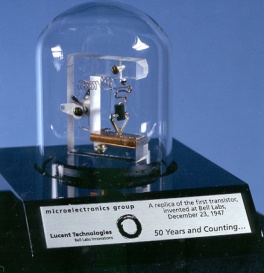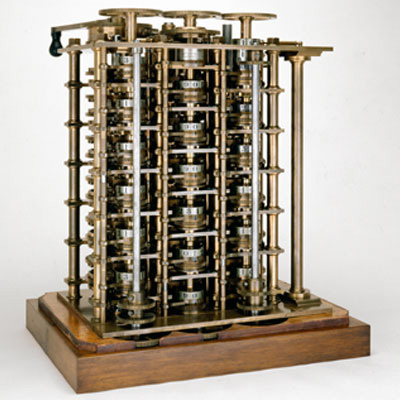

History of Computer Memory
Random Access Memory
Let's start with the basic terminology of the types of RAM memory that most of us are familiar with:
There are two types of RAM:
RAM Photos: 

A good definition for you to remember, "Computer memory refers to the physical devices used to store data or programs (sequence of instructions) on a temporary or permanent basis for use in an electronic digital computer. Computers represent information in binary code, written as sequences of 0s and 1s. Each binary digit (or "bit") may be stored by any physical system that can be in either of two stable states, to represent 0 and 1. Such a system is called bistable." (Wikipedia, 2008).
Ready to test yourself?

Let's focus on the major types of computer memory in history.
Photo - Early Vacuum Tube 1940- 1950:  1950-1960
1950-1960 
Photo- Early Drum Memory 1932  1950's IBM 650
1950's IBM 650 
Magnetic Drum memory video: http://www.youtube.com/watch?v=eIpoA7Ir9p8
Photo - Jay Forrester 1951 files patent for Core Memory 
Photo - 1947 First transistor  Photo - Jack Kilby, Integrated Circuit 1958
Photo - Jack Kilby, Integrated Circuit 1958 
Do you see the evolution link?
Please see this detailed chart. A History of Information Technology and Systems It gives a great timeline of the evolution of computer systems and storage devices.
Here is a link to How Ram Works: http://www.howstuffworks.com/ram.htm
Here is another link on How Computer Ram Works: http://www.articlesbase.com/hardware-articles/how-computer-ram-memory-works-716360.html
Test Yourself !

1801 Joseph Marie Jacquard improved upon a textile loom by introducing a series of punch card paper templates, which allowed the loom to weave intricate patterns automatically.
1833 Charles Babbage constructs the first punch card machine with a memory store called the Analytical Engine . This machine used gears and levers and was programmed by punch cards.This difference engine could solve polynomial equations.
1932 Gustav Tauschek builds first drum memory.
1936 Konrad Zuse builds a mechanical calculator called the Z1.The Z1 was known as the world's first binary computer. Zuse focused on three major elements a calculating device should have.
The Z1 had an electrical engine and was programmed by punch tape. The Z2 had electrical relays and was known as the first electro mechanical computer. The Z3 had micro sequencers and used film tape instead of punch cards.
1946 Mauchly and Eckert develop the Eniac I (Electro Numerical Integrator and Calculator). The Eniac weighed 30 tons! It used Vacuum tubes, relays and switches.
1947 Fredrick Viehe , An Wang and Kenneth Olsen independently invent the magnetic core memory.
Jay Forrester develops the magnetic random access coincident-current drum.
1951 First commercial computer, The Ferranti Mark I . It had a 256 40-bit main memory and magnetic tape storage.
1952 The Edvac computer is created with 1024 44-bit words of ultrasonic memory. The Eniac gets a core memory device.
1954 First mass production of the IBM 650 magnetic tape data storage drum. First commercial ferrite-core memory.
1961 IBM 1401 magnetic core memory series. First transistorized 64-bit memory computer with memory protection and interleaving.IBM 7030 Stretch 64-bit data word and 32/64-bit instruction word computer.
1962 Atlas virtual memory
1965 British computer scientist Maurice Wilkes develops the idea of a cache computer memory. First integrated circuit random access memory application based on Read Only Memory ROM.
1968 Data General launches the 32-kilobytes memory Nova. Analog and digital memory are integrated on one chip by Dedicated Current Source. Robert Dennard invents and patents his Dynamic Random Access Memory DRAM.
1969 Intel creates a 1 Kilobyte RAM chip. (Core Killer)
1970 First generally available Dynamic RAM 256-bit programmable semiconductor memory chip, the Intel 1103i. MOS Dynamic RAM is invented.
Computer memory timeline links: http://inventors.about.com/od/rstartinventions/a/Ram.htm
More detailed timeline information: http://www.lodbrok.be/refpages/timeline.htm




Test Yourself!
We have covered RAM, SRAM and DRAM. There are other types of RAM with distinct properties and differences. Some types you may know, DDR RAM, EDO RAM etc. Here is a link to help you learn the differences of these types of RAM.
http://www.computermemoryupgrade.net/types-of-computer-memory-common-uses.html
http://www.webopedia.com/quick_ref/dram_memory.asp


In conclusion, my main desire is to highlight major technology advancements in the history of RAM. Mary Bellis outlined the importance of the transistor as being crucial to the growth of electronic computing. I agree with her statements. I believe that the inventions by Forrester, Olsen, Wang and Veigh created the most reliable, efficient and cost effective electronic memory which became Random Access Memory. The Inventors.About.Com web article" History of Computer Memory", cites these inventors as being pivital in the creation of modern day computer memory. I agree with web articles findings.
Quiz Time !
Click the red deck of cards to start.
Books:
White, Ron.(2008).How Computers Work. 9th. IN: QUE Publishing 9. Print.
Websites:
Bellis, Mary, NP, web. History of Computer Memory, Retrieved from About.Com Guide, Inventors.http://inventors.about.com/library/weekly/aa050298.htm.
Bellis, Mary, NP Web The History of Vacuum Tubes. Retrieved from http://inventors.about.com/od/uvstartinventions/a/Vacuum_tube.htm
Binary Code: Retrieved from Wikipedia.http://en.wikipedia.org/wiki/Binary_code.
Butler, Jeremy G.(1997) A History of Information Technology and Systems.Retrieved from www.tcf.ua.edu/AZ/ITHistoryOutline.htm
Computer Memory Timeline: Timeline-Help.Retrieved from http://www.timeline-help.com/computer-memory-timeline-3.html.
Computing Timeline: Retrieved from http://www.lodbrok.be/refpages/timeline.htm.
How Computer Ram Works: Article Base.com, NP, Web 2005-2010.Retrieved from http://www.articlesbase.com/hardware-articles/how-computer-ram-memory-works-716360.html.
How Stuff Works-RAM: How Stuff Works Inc.(1998-2010). Retrieved fromhttp://www.howstuffworks.com/ram.htm.
Inventors of the Modern Computer: About.Com Guide, Inventors. NP, Web 10/1/2010 Retrieved from http://inventors.about.com/library/weekly/aa060998.htm.
Konrad Zuse- Introduction: Retrieved from http://user.cs.tu-berlin.de/~zuse/Konrad_Zuse/en/konrad_zuse.html.
Ram: Quin Street Inc. (2010). Retrieved from Webopedia, About Internet.Com,http://www.webopedia.com/TERM/R/RAM.html.
Random Access Memory: Wikipedia NP, Web Retrieved fromhttp://en.wikipedia.org/wiki/Random-access_memory.
The Babbage Engine: The Computer History Museum. NP,Retrieved from http://www.computerhistory.org/babbage/howitworks/.
The History of Computer Memory, About.com, Inventors. NP, Retrieved from http://inventors.about.com/library/weekly/aa060998.htm.
Video:
1950's Early mechanical "Direct Access" Drum Memory Storage. You Tube Video. Retrieved from You Tube http://www.youtube.com/watch?v=eIpoA7Ir9p8.